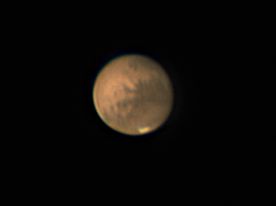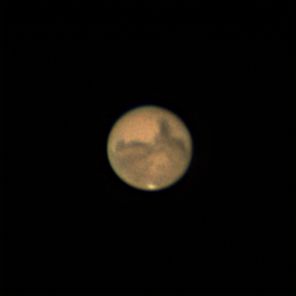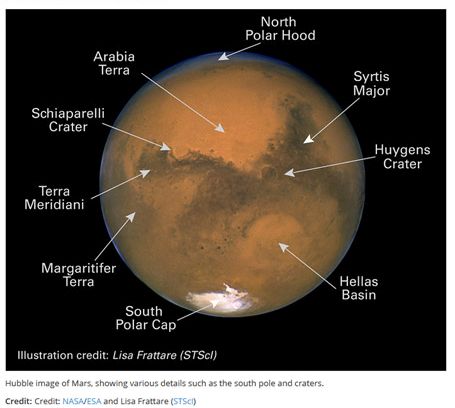The planet Mars was closer to earth on October 6 than it will be anytime in the next 15 years. The closer it is, the larger it appears and the more detail can be seen. Close also means bright – if you go out in the evening just after dark these days, you will see Mars as the really bright red object in the southeast, brighter and redder than any other star or planet,
The orbits of Earth and Mars have sizes and arrangements such that Mars comes closest to the earth (called opposition) about every two years. But some of these oppositions are much closer than others. The one in 2018 was slightly closer than this year. Unfortunately, there was a huge planet-wide dust storm that year that made it virtually impossible to see any details.
But this year is different. No dust storm means that lots of features can be seen – areas of light and dark, representing deserts and exposed rock.
Here is an image I took two weeks ago that shows one side of the planet:
Sep 22, 2020 12:01 AM EDT

Note that the south polar icecap is visible, but since the south pole is currently tilted towards the earth, the north polar icecap is tilted away and cannot be seen.
But here’s an interesting fact – Mars rotates in 24 hours and 40 minutes, just slightly longer than the earth’s 24 hours. This means that if you go out and look at Mars tonight, you will see the almost same side of the planet as you did yesterday at the same time of night.
Another side of the planet
Here is the view nearly two weeks later. The extra 40 minutes per day has added up and now we see another side:
Oct 3, 2020 11:37 PM EDT

As it happens, this side of Mars is the most interesting to see through a small telescope since it includes Syrtis Major – perhaps the easiest Martian feature to make out in a small telescope besides the white polar caps. Between the southern boundary of Syrtis Major and the southern polar cap lies the Hellas Basin. This 2,300km diameter basin is one of the largest impact craters in the Solar System. Hellas can sometimes appear bright due to clouds that form in the basin.
Here is a picture of almost exactly the same side of Mars taken by the Hubble Space Telescope back in 2003. I’m including it here because it is annotated to show the names of the most prominent features, many of which are visible in my image above. Note that the south polar icecap is currently much smaller than it was in August 2003 – it melts away as the Martian southern summer progresses.

How the view changes over three hours
I took a series of images every 15 minutes the night of closest approach and used them to produce this animation showing how Syrtis Major and the other features are seen to move as the planet rotates duing a 3-hour period.
Mars rotates (Oct 5-6, 2020)
.gif)
How my Mars images were made
Like my Jupiter pictures and unlike all the other blog entries I’ve posted before, these pictures were made using my old Meade 8” SCT telescope since its longer focal length provides more magnification – needed for small objects like planets. Instead of stacking many exposures of 2-5 seconds each to reveal dim objects as described in my About page, for planets I use a process called “lucky imaging.”
In “lucky imaging” I record video at approximately 150 frames per second. Although atmospheric turbulance causes the image to swim constantly from instant to instant, some small fraction of the images are better (sharper and more detailed) than the rest. A computer program analyzes each image and keeps only the best 10% of them, and these are then stacked together to produce the final image.